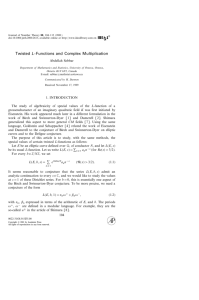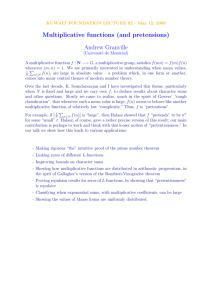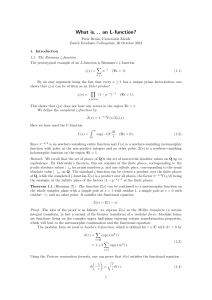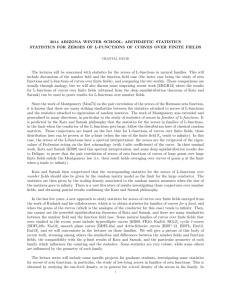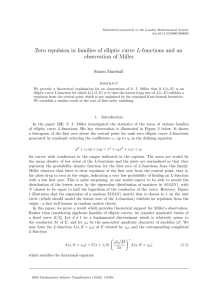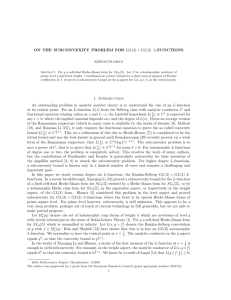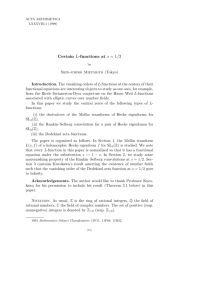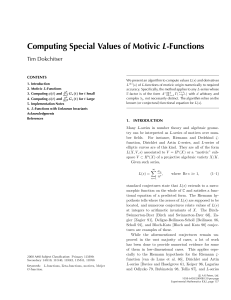L-FUNCTIONS AND CRYPTOGRPHY
advertisement
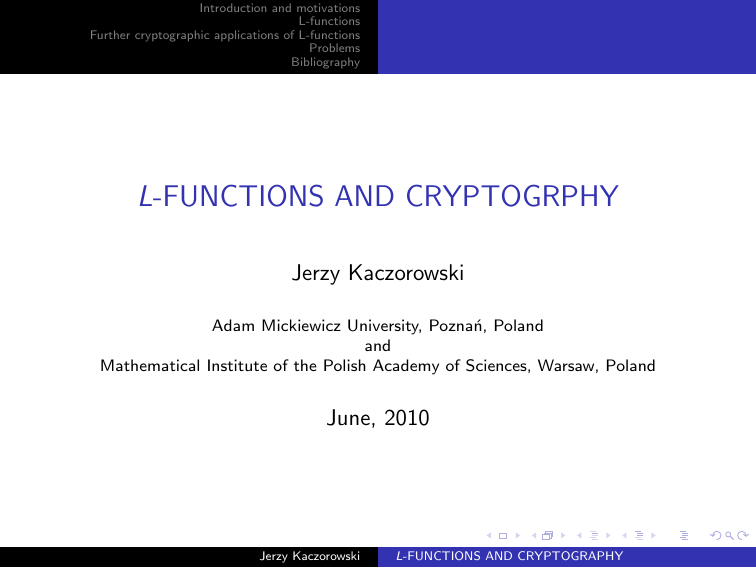
Introduction and motivations
L-functions
Further cryptographic applications of L-functions
Problems
Bibliography
L-FUNCTIONS AND CRYPTOGRPHY
Jerzy Kaczorowski
Adam Mickiewicz University, Poznań, Poland
and
Mathematical Institute of the Polish Academy of Sciences, Warsaw, Poland
June, 2010
Jerzy Kaczorowski
L-FUNCTIONS AND CRYPTOGRAPHY
Introduction and motivations
L-functions
Further cryptographic applications of L-functions
Problems
Bibliography
Authentication using Dirichlet characters
Cryptography and Number Theory
Jerzy Kaczorowski
L-FUNCTIONS AND CRYPTOGRAPHY
Introduction and motivations
L-functions
Further cryptographic applications of L-functions
Problems
Bibliography
Authentication using Dirichlet characters
Cryptography and Number Theory
Cryptography:
Jerzy Kaczorowski
L-FUNCTIONS AND CRYPTOGRAPHY
Introduction and motivations
L-functions
Further cryptographic applications of L-functions
Problems
Bibliography
Authentication using Dirichlet characters
Cryptography and Number Theory
Cryptography:
Algorithms, protocols.
Jerzy Kaczorowski
L-FUNCTIONS AND CRYPTOGRAPHY
Introduction and motivations
L-functions
Further cryptographic applications of L-functions
Problems
Bibliography
Authentication using Dirichlet characters
Cryptography and Number Theory
Cryptography:
Algorithms, protocols.
Number Theory:
Jerzy Kaczorowski
L-FUNCTIONS AND CRYPTOGRAPHY
Introduction and motivations
L-functions
Further cryptographic applications of L-functions
Problems
Bibliography
Authentication using Dirichlet characters
Cryptography and Number Theory
Cryptography:
Algorithms, protocols.
Number Theory:
Seemingly intractable arithmetic problems.
Jerzy Kaczorowski
L-FUNCTIONS AND CRYPTOGRAPHY
Introduction and motivations
L-functions
Further cryptographic applications of L-functions
Problems
Bibliography
Authentication using Dirichlet characters
Cryptography and Number Theory
Cryptography:
Algorithms, protocols.
Number Theory:
Seemingly intractable arithmetic problems:
F integer factorization
Jerzy Kaczorowski
L-FUNCTIONS AND CRYPTOGRAPHY
Introduction and motivations
L-functions
Further cryptographic applications of L-functions
Problems
Bibliography
Authentication using Dirichlet characters
Cryptography and Number Theory
Cryptography:
Algorithms, protocols.
Number Theory:
Seemingly intractable arithmetic problems:
F integer factorization,
F discrete logarithms in algebraic groups
Jerzy Kaczorowski
L-FUNCTIONS AND CRYPTOGRAPHY
Introduction and motivations
L-functions
Further cryptographic applications of L-functions
Problems
Bibliography
Authentication using Dirichlet characters
Cryptography and Number Theory
Cryptography:
Algorithms, protocols.
Number Theory:
Seemingly intractable arithmetic problems:
F integer factorization,
F discrete logarithms in algebraic groups,
F L-function recognition.
Jerzy Kaczorowski
L-FUNCTIONS AND CRYPTOGRAPHY
Introduction and motivations
L-functions
Further cryptographic applications of L-functions
Problems
Bibliography
Authentication using Dirichlet characters
EXAMPLE 1: authentication using Dirichlet characters
(cf. [1]).
Jerzy Kaczorowski
L-FUNCTIONS AND CRYPTOGRAPHY
Introduction and motivations
L-functions
Further cryptographic applications of L-functions
Problems
Bibliography
Authentication using Dirichlet characters
EXAMPLE 1: authentication using Dirichlet characters
(cf. [1]).
Definition: Dirichlet charcter (modq):
Jerzy Kaczorowski
L-FUNCTIONS AND CRYPTOGRAPHY
Introduction and motivations
L-functions
Further cryptographic applications of L-functions
Problems
Bibliography
Authentication using Dirichlet characters
EXAMPLE 1: authentication using Dirichlet characters
(cf. [1]).
Definition: Dirichlet charcter (modq):
a function χ : Z → C satisfying
Jerzy Kaczorowski
L-FUNCTIONS AND CRYPTOGRAPHY
Introduction and motivations
L-functions
Further cryptographic applications of L-functions
Problems
Bibliography
Authentication using Dirichlet characters
EXAMPLE 1: authentication using Dirichlet characters
(cf. [1]).
Definition: Dirichlet charcter (modq):
a function χ : Z → C satisfying
I χ(n) = 0 iff (n, q) > 1,
Jerzy Kaczorowski
L-FUNCTIONS AND CRYPTOGRAPHY
Introduction and motivations
L-functions
Further cryptographic applications of L-functions
Problems
Bibliography
Authentication using Dirichlet characters
EXAMPLE 1: authentication using Dirichlet characters
(cf. [1]).
Definition: Dirichlet charcter (modq):
a function χ : Z → C satisfying
I χ(n) = 0 iff (n, q) > 1,
I χ(n + q) = χ(n),
Jerzy Kaczorowski
L-FUNCTIONS AND CRYPTOGRAPHY
Introduction and motivations
L-functions
Further cryptographic applications of L-functions
Problems
Bibliography
Authentication using Dirichlet characters
EXAMPLE 1: authentication using Dirichlet characters
(cf. [1]).
Definition: Dirichlet charcter (modq):
a function χ : Z → C satisfying
I χ(n) = 0 iff (n, q) > 1,
I χ(n + q) = χ(n),
I χ(nm) = χ(n)χ(m).
Jerzy Kaczorowski
L-FUNCTIONS AND CRYPTOGRAPHY
Introduction and motivations
L-functions
Further cryptographic applications of L-functions
Problems
Bibliography
Authentication using Dirichlet characters
EXAMPLE 1: authentication using Dirichlet characters
(cf. [1]).
Autentication’s layout:
Jerzy Kaczorowski
L-FUNCTIONS AND CRYPTOGRAPHY
Introduction and motivations
L-functions
Further cryptographic applications of L-functions
Problems
Bibliography
Authentication using Dirichlet characters
EXAMPLE 1: authentication using Dirichlet characters
(cf. [1]).
Autentication’s layout:
Alice: the user,
Jerzy Kaczorowski
L-FUNCTIONS AND CRYPTOGRAPHY
Introduction and motivations
L-functions
Further cryptographic applications of L-functions
Problems
Bibliography
Authentication using Dirichlet characters
EXAMPLE 1: authentication using Dirichlet characters
(cf. [1]).
Authentication’s layout:
Alice: the user,
Bob: the authenticator.
Jerzy Kaczorowski
L-FUNCTIONS AND CRYPTOGRAPHY
Introduction and motivations
L-functions
Further cryptographic applications of L-functions
Problems
Bibliography
Authentication using Dirichlet characters
EXAMPLE 1: authentication using Dirichlet characters
(cf. [1]).
Authentication’s layout:
Alice: the user,
Bob: the authenticator.
Both are in possession of a (secret) Dirichlet
character χ(modq).
Jerzy Kaczorowski
L-FUNCTIONS AND CRYPTOGRAPHY
Introduction and motivations
L-functions
Further cryptographic applications of L-functions
Problems
Bibliography
Authentication using Dirichlet characters
EXAMPLE 1: authentication using Dirichlet characters
(cf. [1]).
Authentication’s layout:
Alice: the user,
Bob: the authenticator.
Both are in possession of a (secret) Dirichlet
character χ(modq).
Authentication scheme:
Jerzy Kaczorowski
L-FUNCTIONS AND CRYPTOGRAPHY
Introduction and motivations
L-functions
Further cryptographic applications of L-functions
Problems
Bibliography
Authentication using Dirichlet characters
EXAMPLE 1: authentication using Dirichlet characters
(cf. [1]).
Authentication’s layout:
Alice: the user,
Bob: the authenticator.
Both are in possession of a (secret) Dirichlet
character χ(modq).
Authentication scheme:
Bob sends to Alice: randomly chosen integers m and b > 0,
Jerzy Kaczorowski
L-FUNCTIONS AND CRYPTOGRAPHY
Introduction and motivations
L-functions
Further cryptographic applications of L-functions
Problems
Bibliography
Authentication using Dirichlet characters
EXAMPLE 1: authentication using Dirichlet characters
(cf. [1]).
Authentication’s layout:
Alice: the user,
Bob: the authenticator.
Both are in possession of a (secret) Dirichlet
character χ(modq).
Authentication scheme:
Bob sends to Alice: randomly chosen integers m and b > 0,
Alice sends to Bob: vector v = (χ(m), χ(m + 1), . . . , χ(m + b)),
Jerzy Kaczorowski
L-FUNCTIONS AND CRYPTOGRAPHY
Introduction and motivations
L-functions
Further cryptographic applications of L-functions
Problems
Bibliography
Authentication using Dirichlet characters
EXAMPLE 1: authentication using Dirichlet characters
(cf. [1]).
Authentication’s layout:
Alice: the user,
Bob: the authenticator.
Both are in possession of a (secret) Dirichlet
character χ(modq).
Authentication scheme:
Bob sends to Alice: randomly chosen integers m and b > 0,
Alice sends to Bob: vector v = (χ(m), χ(m + 1), . . . , χ(m + b)),
Bob: If Alice’s list is correct → Alice is an authenticated
user.
Jerzy Kaczorowski
L-FUNCTIONS AND CRYPTOGRAPHY
Introduction and motivations
L-functions
Further cryptographic applications of L-functions
Problems
Bibliography
Authentication using Dirichlet characters
Why does if work?
CONJECTURE (Anshel-Goldfeld [1]) For χ = d· (the Kronecker
symbol) the associated projection
d
d
d
,
,...,
[X , 2X ] 3 d 7→
n
n+1
n+b
where
b ≥ (log X )A
,
m ≤ (log X )B
is a one-way function.
Jerzy Kaczorowski
L-FUNCTIONS AND CRYPTOGRAPHY
Introduction and motivations
L-functions
Further cryptographic applications of L-functions
Problems
Bibliography
Authentication using Dirichlet characters
Why does if work?
CONJECTURE (Anshel-Goldfeld [1]) For χ = d· (the Kronecker
symbol) the associated projection
d
d
d
[X , 2X ] 3 d 7→
,
,...,
n
n+1
n+b
where
b ≥ (log X )A
,
m ≤ (log X )B
is a one-way function.
IMPORTANT: ranges of the parameters b and m.
Jerzy Kaczorowski
L-FUNCTIONS AND CRYPTOGRAPHY
Introduction and motivations
L-functions
Further cryptographic applications of L-functions
Problems
Bibliography
Authentication using Dirichlet characters
GENERALIZATION:
Jerzy Kaczorowski
L-FUNCTIONS AND CRYPTOGRAPHY
Introduction and motivations
L-functions
Further cryptographic applications of L-functions
Problems
Bibliography
Authentication using Dirichlet characters
GENERALIZATION:
Both Alice and Bob are in possession of a (secret)
L-function (<(s) > 1):
Jerzy Kaczorowski
L-FUNCTIONS AND CRYPTOGRAPHY
Introduction and motivations
L-functions
Further cryptographic applications of L-functions
Problems
Bibliography
Authentication using Dirichlet characters
GENERALIZATION:
Both Alice and Bob are in possession of a (secret)
L-function (<(s) > 1):
L(s) =
∞
X
aL (n)
n=1
Jerzy Kaczorowski
ns
.
L-FUNCTIONS AND CRYPTOGRAPHY
Introduction and motivations
L-functions
Further cryptographic applications of L-functions
Problems
Bibliography
Authentication using Dirichlet characters
GENERALIZATION:
Both Alice and Bob are in possession of a (secret)
L-function (<(s) > 1):
L(s) =
∞
X
aL (n)
n=1
ns
.
Authentication scheme:
Jerzy Kaczorowski
L-FUNCTIONS AND CRYPTOGRAPHY
Introduction and motivations
L-functions
Further cryptographic applications of L-functions
Problems
Bibliography
Authentication using Dirichlet characters
GENERALIZATION:
Both Alice and Bob are in possession of a (secret)
L-function (<(s) > 1):
L(s) =
∞
X
aL (n)
n=1
ns
.
Authentication scheme:
Bob sends to Alice: randomly chosen positive integers m and b,
Jerzy Kaczorowski
L-FUNCTIONS AND CRYPTOGRAPHY
Introduction and motivations
L-functions
Further cryptographic applications of L-functions
Problems
Bibliography
Authentication using Dirichlet characters
GENERALIZATION:
Both Alice and Bob are in possession of a (secret)
L-function (<(s) > 1):
L(s) =
∞
X
aL (n)
n=1
ns
.
Authentication scheme:
Bob sends to Alice: randomly chosen positive integers m and b,
Alice sends to Bob: vector v = (aL (m), aL (m + 1), . . . , aL (m + b)),
Jerzy Kaczorowski
L-FUNCTIONS AND CRYPTOGRAPHY
Introduction and motivations
L-functions
Further cryptographic applications of L-functions
Problems
Bibliography
Authentication using Dirichlet characters
GENERALIZATION:
Both Alice and Bob are in possession of a (secret)
L-function (<(s) > 1):
L(s) =
∞
X
aL (n)
n=1
ns
.
Authentication scheme:
Bob sends to Alice: randomly chosen positive integers m and b,
Alice sends to Bob: vector v = (aL (m), aL (m + 1), . . . , aL (m + b)),
Bob: If Alice’s list is correct → Alice is an authenticated
user.
Jerzy Kaczorowski
L-FUNCTIONS AND CRYPTOGRAPHY
Introduction and motivations
L-functions
Further cryptographic applications of L-functions
Problems
Bibliography
Authentication using Dirichlet characters
GENERALIZATION:
Both Alice and Bob are in possession of a (secret)
L-function (<(s) > 1):
L(s) =
∞
X
aL (n)
n=1
ns
.
Authentication scheme:
Bob sends to Alice: randomly chosen positive integers m and b,
Alice sends to Bob: vector v = (aL (m), aL (m + 1), . . . , aL (m + b)),
Bob: If Alice’s list is correct → Alice is an authenticated
user.
Previous example: L(s) = L(s, χ) Dirichlet L-function of χ:
L(s, χ) =
∞
X
χ(n)
n=1
Jerzy Kaczorowski
ns
(<(s) > 1).
L-FUNCTIONS AND CRYPTOGRAPHY
Introduction and motivations
L-functions
Further cryptographic applications of L-functions
Problems
Bibliography
The Selberg class
Definition.
Examples.
General converse conjecture
What is an L-function?
Jerzy Kaczorowski
L-FUNCTIONS AND CRYPTOGRAPHY
Introduction and motivations
L-functions
Further cryptographic applications of L-functions
Problems
Bibliography
The Selberg class
Definition.
Examples.
General converse conjecture
What is an L-function?
“We know one when we see one.”
Jerzy Kaczorowski
L-FUNCTIONS AND CRYPTOGRAPHY
Introduction and motivations
L-functions
Further cryptographic applications of L-functions
Problems
Bibliography
The Selberg class
Definition.
Examples.
General converse conjecture
What is an L-function?
“We know one when we see one.”
Dirichlet series, Euler product, functional equation...
Jerzy Kaczorowski
L-FUNCTIONS AND CRYPTOGRAPHY
Introduction and motivations
L-functions
Further cryptographic applications of L-functions
Problems
Bibliography
The Selberg class
Definition.
Examples.
General converse conjecture
What is an L-function?
“We know one when we see one.”
Dirichlet series, Euler product, functional equation...
Do we know all interesting L-functions?
Jerzy Kaczorowski
L-FUNCTIONS AND CRYPTOGRAPHY
Introduction and motivations
L-functions
Further cryptographic applications of L-functions
Problems
Bibliography
The Selberg class
Definition.
Examples.
General converse conjecture
What is an L-function?
“We know one when we see one.”
Dirichlet series, Euler product, functional equation...
Do we know all interesting L-functions?
We don’t know.
Jerzy Kaczorowski
L-FUNCTIONS AND CRYPTOGRAPHY
Introduction and motivations
L-functions
Further cryptographic applications of L-functions
Problems
Bibliography
The Selberg class
Definition.
Examples.
General converse conjecture
What is an L-function?
“We know one when we see one.”
Dirichlet series, Euler product, functional equation...
Do we know all interesting L-functions?
We don’t know.
Automorphic L-functions?
Jerzy Kaczorowski
L-FUNCTIONS AND CRYPTOGRAPHY
Introduction and motivations
L-functions
Further cryptographic applications of L-functions
Problems
Bibliography
The Selberg class
Definition.
Examples.
General converse conjecture
Definition of S (Selberg, 1989, (cf. [3]))
F ∈ S (the Selberg class) if F (s) =
P∞
a(n)
n=1 ns
where
1. the Dirichlet series converges absolutely for σ > 1.
2. (Analytic continuation) There exists an integer
m ≥ 0 such that (s − 1)m F (s) is entire of finite order.
3. (Functional equation)
Φ(s) = ωΦ(1 − s),
where
Q
Φ(s) = Q s rj=1 Γ(λj s + µj )F (s) = γ(s)F (s), and
r ≥ 0, Q > 0, λj > 0, <µj ≥ 0, |ω| = 1.
Jerzy Kaczorowski
L-FUNCTIONS AND CRYPTOGRAPHY
Introduction and motivations
L-functions
Further cryptographic applications of L-functions
Problems
Bibliography
The Selberg class
Definition.
Examples.
General converse conjecture
Definition of S, continuation
4. (Ramanujan hypothesis) For every ε > 0 we have
a(n) nε .
5. (Euler product) For σ > 1 we have
X
log F (s) =
b(n)n−s ,
n
where b(n) = 0 unless n = p m and b(n) nθ for
some θ < 1/2.
Jerzy Kaczorowski
L-FUNCTIONS AND CRYPTOGRAPHY
Introduction and motivations
L-functions
Further cryptographic applications of L-functions
Problems
Bibliography
The Selberg class
Definition.
Examples.
General converse conjecture
1. Remark: r = 0 is possible — the functional equation
takes form
Q s F (s) = ωQ 1−s F (1 − s).
2. The extended Selberg class S # consists of F (s) not
identically zero satisfying axioms (1), (2) and (3).
Q
3. γ(s) = Q s rj=1 Γ(λj s + µj ) — the gamma factor of
F ∈ S ].
Jerzy Kaczorowski
L-FUNCTIONS AND CRYPTOGRAPHY
Introduction and motivations
L-functions
Further cryptographic applications of L-functions
Problems
Bibliography
The Selberg class
Definition.
Examples.
General converse conjecture
EXAMPLES
1. The Riemann zeta function ζ(s)
Jerzy Kaczorowski
L-FUNCTIONS AND CRYPTOGRAPHY
Introduction and motivations
L-functions
Further cryptographic applications of L-functions
Problems
Bibliography
The Selberg class
Definition.
Examples.
General converse conjecture
EXAMPLES
1. The Riemann zeta function ζ(s)
2. Shifted Dirichlet L-functions L(s + iθ, χ), where χ is
a primitive Dirichlet character (modq), q > 1, and θ
is a real number
Jerzy Kaczorowski
L-FUNCTIONS AND CRYPTOGRAPHY
Introduction and motivations
L-functions
Further cryptographic applications of L-functions
Problems
Bibliography
The Selberg class
Definition.
Examples.
General converse conjecture
EXAMPLES
1. The Riemann zeta function ζ(s)
2. Shifted Dirichlet L-functions L(s + iθ, χ), where χ is
a primitive Dirichlet character (modq), q > 1, and θ
is a real number
3. ζK (s), Dedekind zeta function of an algebraic
number field K
Jerzy Kaczorowski
L-FUNCTIONS AND CRYPTOGRAPHY
Introduction and motivations
L-functions
Further cryptographic applications of L-functions
Problems
Bibliography
The Selberg class
Definition.
Examples.
General converse conjecture
EXAMPLES
1. The Riemann zeta function ζ(s)
2. Shifted Dirichlet L-functions L(s + iθ, χ), where χ is
a primitive Dirichlet character (modq), q > 1, and θ
is a real number
3. ζK (s), Dedekind zeta function of an algebraic
number field K
4. LK (s, χ), Hecke L-function to a primitive Hecke
character χ(modf), f is an ideal of the ring of
integers of K
Jerzy Kaczorowski
L-FUNCTIONS AND CRYPTOGRAPHY
Introduction and motivations
L-functions
Further cryptographic applications of L-functions
Problems
Bibliography
The Selberg class
Definition.
Examples.
General converse conjecture
EXAMPLES, continuation
5. L-function associated with a holomorphic newform of
a congruence subgroup of SL2 (Z) (after suitable
normalization)
6. L-functions of elliptic curves (Wiles)
7. Rankin-Selberg convolution of any two normalized
holomorphic newforms.
8. F , G ∈ S implies FG ∈ S (the same for S # )
9. If F ∈ S is entire then the shift Fθ (s) = F (s + iθ) is
in S for every real θ
Jerzy Kaczorowski
L-FUNCTIONS AND CRYPTOGRAPHY
Introduction and motivations
L-functions
Further cryptographic applications of L-functions
Problems
Bibliography
The Selberg class
Definition.
Examples.
General converse conjecture
Conditional examples
1. Artin L-functions for irreducible representations of
Galois groups (modulo Artin’s conjecture:
holomorphy is missing).
2. L-functions associated with nonholomorphic
newforms (Ramanujan hypothesis is missing,
exceptional eigenvalue problem).
Jerzy Kaczorowski
L-FUNCTIONS AND CRYPTOGRAPHY
Introduction and motivations
L-functions
Further cryptographic applications of L-functions
Problems
Bibliography
The Selberg class
Definition.
Examples.
General converse conjecture
Conditional examples, continuation
3. Symmetric powers (for normalized holomorphic
newforms, say):
Y
ap −1
bp −1
L(s) =
1− s
1− s
p
p
p
r -th symmetric power:
r
YY
Lr (s) =
(1 − apj bpr −j p −s )−1
p j=0
(modulo Langlands functoriality conjecture).
4. In general: GLn (K ) automorphic L functions
(Ramanujan hypothesis is missing).
5. Motivic L-functions (analytic continuation is
missing).
Jerzy Kaczorowski
L-FUNCTIONS AND CRYPTOGRAPHY
Introduction and motivations
L-functions
Further cryptographic applications of L-functions
Problems
Bibliography
The Selberg class
Definition.
Examples.
General converse conjecture
Examples, continuation
General examples of L-functions from the extended
Selberg class: linear combinations of solutions of the
same functional equation as for instance the
Davenport-Heilbronn L-function.
L(s) = λL(s, χ1 ) + λL(s, χ1 ),
χ1 (mod5) such that χ1 (2) = i,
√
√
10−2
5−2
1
√
λ= 2 1+i
.
5−1
Functional equation
π s s + 1
π 1−s 2 − s 2
2
Γ
L(s) =
Γ
L(1−s).
5
2
5
2
Jerzy Kaczorowski
L-FUNCTIONS AND CRYPTOGRAPHY
Introduction and motivations
L-functions
Further cryptographic applications of L-functions
Problems
Bibliography
The Selberg class
Definition.
Examples.
General converse conjecture
The basic problem of the Selberg class theory
Let L ∈ S satisfy the following functional equation
Φ(s) = ωΦ(1 − s),
where
Q
Φ(s) = Q s rj=1 Γ(λj s + µj )F (s) = γ(s)F (s), and
r ≥ 0, Q > 0, λj > 0, <µj ≥ 0, |ω| = 1.
Jerzy Kaczorowski
L-FUNCTIONS AND CRYPTOGRAPHY
Introduction and motivations
L-functions
Further cryptographic applications of L-functions
Problems
Bibliography
The Selberg class
Definition.
Examples.
General converse conjecture
The basic problem of the Selberg class theory
Let L ∈ S satisfy the following functional equation
Φ(s) = ωΦ(1 − s),
where
Q
Φ(s) = Q s rj=1 Γ(λj s + µj )F (s) = γ(s)F (s), and
r ≥ 0, Q > 0, λj > 0, <µj ≥ 0, |ω| = 1.
P
Degree of L: dL = 2 rj=1 λj
Jerzy Kaczorowski
L-FUNCTIONS AND CRYPTOGRAPHY
Introduction and motivations
L-functions
Further cryptographic applications of L-functions
Problems
Bibliography
The Selberg class
Definition.
Examples.
General converse conjecture
The basic problem of the Selberg class theory
General Converse Conjecture
Jerzy Kaczorowski
L-FUNCTIONS AND CRYPTOGRAPHY
Introduction and motivations
L-functions
Further cryptographic applications of L-functions
Problems
Bibliography
The Selberg class
Definition.
Examples.
General converse conjecture
The basic problem of the Selberg class theory
General Converse Conjecture
(1) (Degree conjecture) dL ∈ Z for all L ∈ S;
Jerzy Kaczorowski
L-FUNCTIONS AND CRYPTOGRAPHY
Introduction and motivations
L-functions
Further cryptographic applications of L-functions
Problems
Bibliography
The Selberg class
Definition.
Examples.
General converse conjecture
The basic problem of the Selberg class theory
General Converse Conjecture
(1) (Degree conjecture) dL ∈ Z for all L ∈ S;
(2) All L of integer degree are suitably normalized
L-functions of automorphic representations.
Jerzy Kaczorowski
L-FUNCTIONS AND CRYPTOGRAPHY
Introduction and motivations
L-functions
Further cryptographic applications of L-functions
Problems
Bibliography
The Selberg class
Definition.
Examples.
General converse conjecture
The basic problem of the Selberg class theory
General Converse Conjecture
(1) (Degree conjecture) dL ∈ Z for all L ∈ S;
(2) All L of integer degree are suitably normalized
L-functions of automorphic representations.
THEOREM ([4]) GCC is true for 0 ≤ d < 2.
Jerzy Kaczorowski
L-FUNCTIONS AND CRYPTOGRAPHY
Introduction and motivations
L-functions
Further cryptographic applications of L-functions
Problems
Bibliography
Elliptic curve Pseudorandom Generator
Coin flipping by telephone
Further cryptographic applications of L-functions
EXAMPLE 2: Elliptic curve PRG, (cf. [1])
DEFINITION: PRG is a deterministic polynomial time algorithm
that expands short seeds into longer bit sequences
such that the output of the ensemble is
polynomial-time indistinguishable from a target
probability distribution.
Jerzy Kaczorowski
L-FUNCTIONS AND CRYPTOGRAPHY
Introduction and motivations
L-functions
Further cryptographic applications of L-functions
Problems
Bibliography
Elliptic curve Pseudorandom Generator
Coin flipping by telephone
Further cryptographic applications of L-functions
EXAMPLE 2: Elliptic curve PRG (cf. [1])
Elliptic curves over Q
a, b ∈ Z, ∆E := 4a3 + 27b 2 6= 0
E (Q) = {(x, y ) ∈ Q : y 2 = x 3 + ax + b} ∪ {(∞, ∞)}
Jerzy Kaczorowski
L-FUNCTIONS AND CRYPTOGRAPHY
Introduction and motivations
L-functions
Further cryptographic applications of L-functions
Problems
Bibliography
Elliptic curve Pseudorandom Generator
Coin flipping by telephone
Further cryptographic applications of L-functions
EXAMPLE 2: Elliptic curve PRG (cf. [1])
Elliptic curves over Q
a, b ∈ Z, ∆E := 4a3 + 27b 2 6= 0
E (Q) = {(x, y ) ∈ Q : y 2 = x 3 + ax + b} ∪ {(∞, ∞)}
Good reduction: For p 6 |∆E
y 2 ≡ x 3 + ax + b(modp)
defines an elliptic curve over Fp .
For p 6 |∆E :
aE (p) = p + 1 − #E (Fp ).
Jerzy Kaczorowski
L-FUNCTIONS AND CRYPTOGRAPHY
Introduction and motivations
L-functions
Further cryptographic applications of L-functions
Problems
Bibliography
Elliptic curve Pseudorandom Generator
Coin flipping by telephone
THEOREM (A. Wiles et al. + multiplicity one property of
automorphic representations) There exist uniquely
determined integers aE (p), p|∆E such that
L(s, E ) =
−1
Y aE (p)
aE (p) −1 Y
1−2s
1−
+p
1−
ps
ps
p-∆E
p|∆E
defined for <(s) > 3/2 extends to an entire function
satisfying the following functional equation:
Q s Γ(s)L(s, E ) = ωQ 2−s Γ(2 − s)L(2 − s, E )
with ω = ±1.
Jerzy Kaczorowski
L-FUNCTIONS AND CRYPTOGRAPHY
Introduction and motivations
L-functions
Further cryptographic applications of L-functions
Problems
Bibliography
COROLLARY We have
1.
L(s, E ) =
Elliptic curve Pseudorandom Generator
Coin flipping by telephone
∞
X
aE (n)
n=1
ns
(<(s) > 3/2),
2. aE (n) ∈ Z,
√
3. |aE (n)| ≤ nd(n) (Deligne),
4. aE (p k ) can be computed in a polynomial time
(Schoof),
5. L(s + 12 , E ) ∈ S.
Jerzy Kaczorowski
L-FUNCTIONS AND CRYPTOGRAPHY
Introduction and motivations
L-functions
Further cryptographic applications of L-functions
Problems
Bibliography
Elliptic curve Pseudorandom Generator
Coin flipping by telephone
THEOREM ([1]) Let a, b ∈ Z be such that 4a3 + 27b 2 6= 0, and
let the splitting field of the polynomial
X 3 + aX + b ∈ Q[X ]
has degree 6 over Q. Then the density of primes p
for which aE (p) is even is 2/3:
X
2
1
1= .
x→∞ π(x)
3
lim
p≤x
2|aE (p)
Jerzy Kaczorowski
L-FUNCTIONS AND CRYPTOGRAPHY
Introduction and motivations
L-functions
Further cryptographic applications of L-functions
Problems
Bibliography
Elliptic curve Pseudorandom Generator
Coin flipping by telephone
THEOREM ([1]) Let a, b ∈ Z be such that 4a3 + 27b 2 6= 0, and
let the splitting field of the polynomial
X 3 + aX + b ∈ Q[X ]
has degree 6 over Q. Then the density of primes p
for which aE (p) is even is 2/3:
X
2
1
1= .
x→∞ π(x)
3
lim
p≤x
2|aE (p)
PROOF: Artin’s conjecture for S3 and Chebotarev density
theorem.
Jerzy Kaczorowski
L-FUNCTIONS AND CRYPTOGRAPHY
Introduction and motivations
L-functions
Further cryptographic applications of L-functions
Problems
Bibliography
Elliptic curve Pseudorandom Generator
Coin flipping by telephone
Elliptic Curve Pseudorandom Generator ([1])
Jerzy Kaczorowski
L-FUNCTIONS AND CRYPTOGRAPHY
Introduction and motivations
L-functions
Further cryptographic applications of L-functions
Problems
Bibliography
Elliptic curve Pseudorandom Generator
Coin flipping by telephone
Elliptic Curve Pseudorandom Generator ([1])
INPUT: a, b ∈ Z such that
1. 4a3 + 27b 2 6= 0,
2. the degree of the splitting field of X 3 + aX + b
is of degree 6 over Q.
Jerzy Kaczorowski
L-FUNCTIONS AND CRYPTOGRAPHY
Introduction and motivations
L-functions
Further cryptographic applications of L-functions
Problems
Bibliography
Elliptic curve Pseudorandom Generator
Coin flipping by telephone
Elliptic Curve Pseudorandom Generator ([1])
INPUT: a, b ∈ Z such that
1. 4a3 + 27b 2 6= 0,
2. the degree of the splitting field of X 3 + aX + b
is of degree 6 over Q.
Integer pair (a, b) is the SEED of the PRG.
Jerzy Kaczorowski
L-FUNCTIONS AND CRYPTOGRAPHY
Introduction and motivations
L-functions
Further cryptographic applications of L-functions
Problems
Bibliography
Elliptic curve Pseudorandom Generator
Coin flipping by telephone
Elliptic Curve Pseudorandom Generator ([1])
INPUT: a, b ∈ Z such that
1. 4a3 + 27b 2 6= 0,
2. the degree of the splitting field of X 3 + aX + b
is of degree 6 over Q.
Integer pair (a, b) is the SEED of the PRG.
OUTPUT: The binary string
(aE (p1 )(mod2), aE (p2 )(mod2), . . .)
where 3 = p1 < p2 < . . . is the sequence of odd
primes.
Jerzy Kaczorowski
L-FUNCTIONS AND CRYPTOGRAPHY
Introduction and motivations
L-functions
Further cryptographic applications of L-functions
Problems
Bibliography
Elliptic curve Pseudorandom Generator
Coin flipping by telephone
Elliptic Curve Pseudorandom Generator ([1])
INPUT: a, b ∈ Z such that
1. 4a3 + 27b 2 6= 0,
2. the degree of the splitting field of X 3 + aX + b
is of degree 6 over Q.
Integer pair (a, b) is the SEED of the PRG.
OUTPUT: The binary string
(aE (p1 )(mod2), aE (p2 )(mod2), . . .)
where 3 = p1 < p2 < . . . is the sequence of odd
primes.
FACT: ([1]) This is a pseudorandom sequence with
probability distribution (1/3, 2/3).
Jerzy Kaczorowski
L-FUNCTIONS AND CRYPTOGRAPHY
Introduction and motivations
L-functions
Further cryptographic applications of L-functions
Problems
Bibliography
Elliptic curve Pseudorandom Generator
Coin flipping by telephone
GENERALIZATION: Apply the same procedure to any L-function.
Jerzy Kaczorowski
L-FUNCTIONS AND CRYPTOGRAPHY
Introduction and motivations
L-functions
Further cryptographic applications of L-functions
Problems
Bibliography
Elliptic curve Pseudorandom Generator
Coin flipping by telephone
EXAMPLE 3: Coin flipping by telephone
Preparations:
Jerzy Kaczorowski
L-FUNCTIONS AND CRYPTOGRAPHY
Introduction and motivations
L-functions
Further cryptographic applications of L-functions
Problems
Bibliography
Elliptic curve Pseudorandom Generator
Coin flipping by telephone
EXAMPLE 3: Coin flipping by telephone
Preparations:
Step I: Alice chooses:
Jerzy Kaczorowski
L-FUNCTIONS AND CRYPTOGRAPHY
Introduction and motivations
L-functions
Further cryptographic applications of L-functions
Problems
Bibliography
Elliptic curve Pseudorandom Generator
Coin flipping by telephone
EXAMPLE 3: Coin flipping by telephone
Preparations:
Step I: Alice chooses:
(a) an L-function of conductor q,
Jerzy Kaczorowski
L-FUNCTIONS AND CRYPTOGRAPHY
Introduction and motivations
L-functions
Further cryptographic applications of L-functions
Problems
Bibliography
Elliptic curve Pseudorandom Generator
Coin flipping by telephone
EXAMPLE 3: Coin flipping by telephone
Preparations:
Step I: Alice chooses:
(a) an L-function of conductor q,
(b) parameters T , x ∈ R, N ∈ N ( N ∼ T θ , θ > 1/2),
Jerzy Kaczorowski
L-FUNCTIONS AND CRYPTOGRAPHY
Introduction and motivations
L-functions
Further cryptographic applications of L-functions
Problems
Bibliography
Elliptic curve Pseudorandom Generator
Coin flipping by telephone
EXAMPLE 3: Coin flipping by telephone
Preparations:
Step I: Alice chooses:
(a) an L-function of conductor q,
(b) parameters T , x ∈ R, N ∈ N ( N ∼ T θ , θ > 1/2),
(c) E ⊂ [0, 1) of Jordan measure 1/2.
Jerzy Kaczorowski
L-FUNCTIONS AND CRYPTOGRAPHY
Introduction and motivations
L-functions
Further cryptographic applications of L-functions
Problems
Bibliography
Elliptic curve Pseudorandom Generator
Coin flipping by telephone
EXAMPLE 3: Coin flipping by telephone
Preparations:
Step I: Alice chooses:
(a) an L-function of conductor q,
(b) parameters T , x ∈ R, N ∈ N ( N ∼ T θ , θ > 1/2),
(c) E ⊂ [0, 1) of Jordan measure 1/2.
Step II: Alice computes consecutive non-trivial zeros
ρ1 , ρ2 , . . . , ρN of L(s) on the line σ = 1/2:
ρj =
1
+ iγj
2
T ≤ γ1 ≤ γ2 ≤ . . . ≤ γN .
Jerzy Kaczorowski
L-FUNCTIONS AND CRYPTOGRAPHY
Introduction and motivations
L-functions
Further cryptographic applications of L-functions
Problems
Bibliography
Elliptic curve Pseudorandom Generator
Coin flipping by telephone
EXAMPLE 3: Coin flipping by telephone
Preparations:
Step I: Alice chooses:
(a) an L-function of conductor q,
(b) parameters T , x ∈ R, N ∈ N ( N ∼ T θ , θ > 1/2),
(c) E ⊂ [0, 1) of Jordan measure 1/2.
Step II: Alice computes consecutive non-trivial zeros
ρ1 , ρ2 , . . . , ρN of L(s) on the line σ = 1/2:
1
ρj = + iγj
2
T ≤ γ1 ≤ γ2 ≤ . . . ≤ γN .
Step III: Alice sends to Bob N and the vector
v = (aL (2), aL (3), . . . , aL (m))
m ∼ [(log q)κ ] ,
Jerzy Kaczorowski
κ > 2.
L-FUNCTIONS AND CRYPTOGRAPHY
Introduction and motivations
L-functions
Further cryptographic applications of L-functions
Problems
Bibliography
Elliptic curve Pseudorandom Generator
Coin flipping by telephone
EXAMPLE 3: Coin flipping by telephone
The Algorithm
Jerzy Kaczorowski
L-FUNCTIONS AND CRYPTOGRAPHY
Introduction and motivations
L-functions
Further cryptographic applications of L-functions
Problems
Bibliography
Elliptic curve Pseudorandom Generator
Coin flipping by telephone
EXAMPLE 3: Coin flipping by telephone
The Algorithm
Bob: sends to Alice a random integer 1 ≤ m ≤ N.
Jerzy Kaczorowski
L-FUNCTIONS AND CRYPTOGRAPHY
Introduction and motivations
L-functions
Further cryptographic applications of L-functions
Problems
Bibliography
Elliptic curve Pseudorandom Generator
Coin flipping by telephone
EXAMPLE 3: Coin flipping by telephone
The Algorithm
Bob: sends to Alice a random integer 1 ≤ m ≤ N.
Alice: Returns εm ∈ {0, 1} computed as follows:
1
if
||xγm || ∈ E ,
εm =
0 othervise.
Jerzy Kaczorowski
L-FUNCTIONS AND CRYPTOGRAPHY
Introduction and motivations
L-functions
Further cryptographic applications of L-functions
Problems
Bibliography
Elliptic curve Pseudorandom Generator
Coin flipping by telephone
EXAMPLE 3: Coin flipping by telephone
The Algorithm
Bob: sends to Alice a random integer 1 ≤ m ≤ N.
Alice: Returns εm ∈ {0, 1} computed as follows:
1
if
||xγm || ∈ E ,
εm =
0 othervise.
If εm = 1 the coin toss is HEADS,
Jerzy Kaczorowski
L-FUNCTIONS AND CRYPTOGRAPHY
Introduction and motivations
L-functions
Further cryptographic applications of L-functions
Problems
Bibliography
Elliptic curve Pseudorandom Generator
Coin flipping by telephone
EXAMPLE 3: Coin flipping by telephone
The Algorithm
Bob: sends to Alice a random integer 1 ≤ m ≤ N.
Alice: Returns εm ∈ {0, 1} computed as follows:
1
if
||xγm || ∈ E ,
εm =
0 othervise.
If εm = 1 the coin toss is HEADS,
If εm = 0 the coin toss is TAILS.
Jerzy Kaczorowski
L-FUNCTIONS AND CRYPTOGRAPHY
Introduction and motivations
L-functions
Further cryptographic applications of L-functions
Problems
Bibliography
Elliptic curve Pseudorandom Generator
Coin flipping by telephone
EXAMPLE 3: Coin flipping by telephone
Verification: Bob can verify the correctness of the coin flipp when
Alice announces L, T , x and E .
Jerzy Kaczorowski
L-FUNCTIONS AND CRYPTOGRAPHY
Introduction and motivations
L-functions
Further cryptographic applications of L-functions
Problems
Bibliography
Elliptic curve Pseudorandom Generator
Coin flipping by telephone
Why does it work?
Jerzy Kaczorowski
L-FUNCTIONS AND CRYPTOGRAPHY
Introduction and motivations
L-functions
Further cryptographic applications of L-functions
Problems
Bibliography
Elliptic curve Pseudorandom Generator
Coin flipping by telephone
Why does it work?
Let
0 < γ1 ≤ γ2 ≤ . . .
be positive imaginary parts of non-trivial zeros of the
Riemann zeta function.
Jerzy Kaczorowski
L-FUNCTIONS AND CRYPTOGRAPHY
Introduction and motivations
L-functions
Further cryptographic applications of L-functions
Problems
Bibliography
Elliptic curve Pseudorandom Generator
Coin flipping by telephone
Why does it work?
Let
0 < γ1 ≤ γ2 ≤ . . .
be positive imaginary parts of non-trivial zeros of the
Riemann zeta function.
Theorem (E. Hlawka) For every real x 6= 0 the sequence (xγk )
is uniformly distributed (mod 1) in the sense of H.
Weyl:
∀0≤a<b<1 #{k ≤ N : a ≤ ||xγk || < b} ∼ (b − a)N
as N → ∞.
Jerzy Kaczorowski
L-FUNCTIONS AND CRYPTOGRAPHY
Introduction and motivations
L-functions
Further cryptographic applications of L-functions
Problems
Bibliography
Elliptic curve Pseudorandom Generator
Coin flipping by telephone
Why does it work?
Let
0 < γ1 ≤ γ2 ≤ . . .
be positive imaginary parts of non-trivial zeros of the
Riemann zeta function.
Theorem (E. Hlawka) For every real x 6= 0 the sequence (xγk )
is uniformly distributed (mod 1) in the sense of H.
Weyl:
∀0≤a<b<1 #{k ≤ N : a ≤ ||xγk || < b} ∼ (b − a)N
as N → ∞.
Generalizations: P.D.T.A. Elliott, A. Fuji, H.
Rademacher, J.K. . . .
Jerzy Kaczorowski
L-FUNCTIONS AND CRYPTOGRAPHY
Introduction and motivations
L-functions
Further cryptographic applications of L-functions
Problems
Bibliography
Elliptic curve Pseudorandom Generator
Coin flipping by telephone
A-U.D. (mod 1)
Jerzy Kaczorowski
L-FUNCTIONS AND CRYPTOGRAPHY
Introduction and motivations
L-functions
Further cryptographic applications of L-functions
Problems
Bibliography
Elliptic curve Pseudorandom Generator
Coin flipping by telephone
A-U.D. (mod 1)
For simplicity: the case of Dirichlet L-functions.
Jerzy Kaczorowski
L-FUNCTIONS AND CRYPTOGRAPHY
Introduction and motivations
L-functions
Further cryptographic applications of L-functions
Problems
Bibliography
Elliptic curve Pseudorandom Generator
Coin flipping by telephone
A-U.D. (mod 1)
For simplicity: the case of Dirichlet L-functions.
? Let
0 < γ1 ≤ γ2 ≤ . . .
be positive imaginary parts of non-trivial zeros of
L(s, χ).
Jerzy Kaczorowski
L-FUNCTIONS AND CRYPTOGRAPHY
Introduction and motivations
L-functions
Further cryptographic applications of L-functions
Problems
Bibliography
Elliptic curve Pseudorandom Generator
Coin flipping by telephone
A-U.D. (mod 1)
For simplicity: the case of Dirichlet L-functions.
? Let
0 < γ1 ≤ γ2 ≤ . . .
be positive imaginary parts of non-trivial zeros of
L(s, χ).
? The positive Toeplitz matrix:
Jerzy Kaczorowski
L-FUNCTIONS AND CRYPTOGRAPHY
Introduction and motivations
L-functions
Further cryptographic applications of L-functions
Problems
Bibliography
Elliptic curve Pseudorandom Generator
Coin flipping by telephone
A-U.D. (mod 1)
For simplicity: the case of Dirichlet L-functions.
? Let
0 < γ1 ≤ γ2 ≤ . . .
be positive imaginary parts of non-trivial zeros of
L(s, χ).
? The positive Toeplitz matrix:
A = [ank ]n,k≥1
Jerzy Kaczorowski
L-FUNCTIONS AND CRYPTOGRAPHY
Introduction and motivations
L-functions
Further cryptographic applications of L-functions
Problems
Bibliography
Elliptic curve Pseudorandom Generator
Coin flipping by telephone
A-U.D. (mod 1)
For simplicity: the case of Dirichlet L-functions.
? Let
0 < γ1 ≤ γ2 ≤ . . .
be positive imaginary parts of non-trivial zeros of
L(s, χ).
? The positive Toeplitz matrix:
A = [ank ]n,k≥1
ank =
Jerzy Kaczorowski
1 −γk n
e γk ,
Sn
L-FUNCTIONS AND CRYPTOGRAPHY
Introduction and motivations
L-functions
Further cryptographic applications of L-functions
Problems
Bibliography
Elliptic curve Pseudorandom Generator
Coin flipping by telephone
A-U.D. (mod 1)
For simplicity: the case of Dirichlet L-functions.
? Let
0 < γ1 ≤ γ2 ≤ . . .
be positive imaginary parts of non-trivial zeros of
L(s, χ).
? The positive Toeplitz matrix:
A = [ank ]n,k≥1
1 −γk n
e γk ,
Sn
∞
X
Sn =
e −γk γkn .
ank =
k=1
Jerzy Kaczorowski
L-FUNCTIONS AND CRYPTOGRAPHY
Introduction and motivations
L-functions
Further cryptographic applications of L-functions
Problems
Bibliography
Elliptic curve Pseudorandom Generator
Coin flipping by telephone
A-U.D. (mod 1)
THEOREM ([2]) For every real x 6= 0 the sequence xγk is
A-uniformly distributed (mod 1):
X
∀0≤a<b<1
ank → (b − a)
k≥1
a≤||xγk ||<b
as N → ∞.
Jerzy Kaczorowski
L-FUNCTIONS AND CRYPTOGRAPHY
Introduction and motivations
L-functions
Further cryptographic applications of L-functions
Problems
Bibliography
Elliptic curve Pseudorandom Generator
Coin flipping by telephone
A-U.D. (mod 1)
THEOREM ([2]) Weyl uniform distribution (mod 1) is of type 1,
whereas A-uniform distribution (mod 1) is of type
1/2.
Jerzy Kaczorowski
L-FUNCTIONS AND CRYPTOGRAPHY
Introduction and motivations
L-functions
Further cryptographic applications of L-functions
Problems
Bibliography
Elliptic curve Pseudorandom Generator
Coin flipping by telephone
A-U.D. (mod 1)
THEOREM ([2]) Weyl uniform distribution (mod 1) is of type 1,
whereas A-uniform distribution (mod 1) is of type
1/2.
COROLLARY Suppose (tk ) is A-u.d. (mod 1). Then every finite
subsequence
(tk )N+H
k=N
,
H ≥ N 1/2+ε
fills approximately uniformly [0, 1).
Jerzy Kaczorowski
L-FUNCTIONS AND CRYPTOGRAPHY
Introduction and motivations
L-functions
Further cryptographic applications of L-functions
Problems
Bibliography
Elliptic curve Pseudorandom Generator
Coin flipping by telephone
A-U.D. (mod 1)
THEOREM ([2]) Weyl uniform distribution (mod 1) is of type 1,
whereas A-uniform distribution (mod 1) is of type
1/2.
COROLLARY Suppose (tk ) is A-u.d. (mod 1). Then every finite
subsequence
(tk )N+H
k=N
,
H ≥ N 1/2+ε
fills approximately uniformly [0, 1).
HENCE: For N → ∞ the probability that a randomly chosen
tk
N ≤ k ≤ N + N 1/2+ε
lands in E ⊂ [0, 1) tends to the Jordan measure of E .
Jerzy Kaczorowski
L-FUNCTIONS AND CRYPTOGRAPHY
Introduction and motivations
L-functions
Further cryptographic applications of L-functions
Problems
Bibliography
Elliptic curve Pseudorandom Generator
Coin flipping by telephone
This justifies the choice of parameters of the coin
flipping scheme:
Jerzy Kaczorowski
L-FUNCTIONS AND CRYPTOGRAPHY
Introduction and motivations
L-functions
Further cryptographic applications of L-functions
Problems
Bibliography
Elliptic curve Pseudorandom Generator
Coin flipping by telephone
This justifies the choice of parameters of the coin
flipping scheme:
? N = T θ with θ > 1/2 since A-u.d. (mod 1) is of
type 1/2;
Jerzy Kaczorowski
L-FUNCTIONS AND CRYPTOGRAPHY
Introduction and motivations
L-functions
Further cryptographic applications of L-functions
Problems
Bibliography
Elliptic curve Pseudorandom Generator
Coin flipping by telephone
This justifies the choice of parameters of the coin
flipping scheme:
? N = T θ with θ > 1/2 since A-u.d. (mod 1) is of
type 1/2;
? Jordan measure of E ⊂ [0, 1) being 1/2 implies
Prob(HEADS) = Prob(TAILS) = 1/2.
Jerzy Kaczorowski
L-FUNCTIONS AND CRYPTOGRAPHY
Introduction and motivations
L-functions
Further cryptographic applications of L-functions
Problems
Bibliography
Elliptic curve Pseudorandom Generator
Coin flipping by telephone
Generalization: Apply the same procedure for an arbitrary
L-function.
Jerzy Kaczorowski
L-FUNCTIONS AND CRYPTOGRAPHY
Introduction and motivations
L-functions
Further cryptographic applications of L-functions
Problems
Bibliography
SOME OPEN PROBLEMS:
Jerzy Kaczorowski
L-FUNCTIONS AND CRYPTOGRAPHY
Introduction and motivations
L-functions
Further cryptographic applications of L-functions
Problems
Bibliography
SOME OPEN PROBLEMS:
1. Provide algorithms for generating ‘large’ families of
L-functions.
Jerzy Kaczorowski
L-FUNCTIONS AND CRYPTOGRAPHY
Introduction and motivations
L-functions
Further cryptographic applications of L-functions
Problems
Bibliography
SOME OPEN PROBLEMS:
1. Provide algorithms for generating ‘large’ families of
L-functions.
2. Provide algorithms for calculating Dirichlet
coefficients of L-functions (for all n or for prime
powers).
Jerzy Kaczorowski
L-FUNCTIONS AND CRYPTOGRAPHY
Introduction and motivations
L-functions
Further cryptographic applications of L-functions
Problems
Bibliography
SOME OPEN PROBLEMS:
1. Provide algorithms for generating ‘large’ families of
L-functions.
2. Provide algorithms for calculating Dirichlet
coefficients of L-functions (for all n or for prime
powers).
3. Provide (fast) algorithms for calculating non-trivial
zeros of L-functions.
Jerzy Kaczorowski
L-FUNCTIONS AND CRYPTOGRAPHY
Introduction and motivations
L-functions
Further cryptographic applications of L-functions
Problems
Bibliography
SOME OPEN PROBLEMS:
1. Provide algorithms for generating ‘large’ families of
L-functions.
2. Provide algorithms for calculating Dirichlet
coefficients of L-functions (for all n or for prime
powers).
3. Provide (fast) algorithms for calculating non-trivial
zeros of L-functions.
4. . . .
Jerzy Kaczorowski
L-FUNCTIONS AND CRYPTOGRAPHY
Introduction and motivations
L-functions
Further cryptographic applications of L-functions
Problems
Bibliography
Bibliography
[1] M. Anshel, D. Goldfeld, Zeta functions, one-way
functions, and pseudorandom number generators,
Duke Math. J. 88(1997), 371–390.
[2] J. Kaczorowski, The k-functions in multiplicative
number theory, II, III, Acta Arith. 56(1990),
213–224; ibidem 57(1990), 199–210.
[3] J. Kaczorowski, Axiomatic theory of L-functions:
the Selberg class, in Analytic Number Theory,
C.I.M.E. Summer School,Cetraro (Italy) 2002, ed. by
A. Perelli, C. Viola, 133–209, Springer L.N. 1891,
2006.
[4] J. Kaczorowski, A. Perelli, On the structure of the
Selberg class, I, VII, Acta Math. 182(1999),
207-241; to appear in Annals of Math.
Jerzy Kaczorowski
L-FUNCTIONS AND CRYPTOGRAPHY
Introduction and motivations
L-functions
Further cryptographic applications of L-functions
Problems
Bibliography
Th (a, n)k = y (0, u)!
Jerzy Kaczorowski
L-FUNCTIONS AND CRYPTOGRAPHY

